
acer extensa 5635
.pdf
Chapter 4
Troubleshooting
Common Problems
Use the following procedure as a guide for computer problems.
NOTE: The diagnostic tests are intended to test only Acer products. Non-Acer products, prototype cards, or modified options can give false errors and invalid system responses.
1.Obtain the failing symptoms in as much detail as possible.
2.Verify the symptoms by attempting to re-create the failure by running the diagnostic test or by repeating the same operation.
3.Use the following table with the verified symptom to determine which page to go to.
Symptoms (Verified) |
Go To |
|
|
Power On Issue |
Page 92 |
|
|
No Display Issue |
Page 93 |
|
|
LCD Failure |
Page 96 |
|
|
Internal Keyboard Failure |
Page 97 |
|
|
TouchPad Failure |
Page 98 |
|
|
Internal Speaker Failure |
Page 99 |
|
|
Internal Microphone Failure |
Page 101 |
|
|
Right Side USB Failure |
Page 103 |
|
|
Other Functions Failure |
Page 105 |
|
|
Intermittent Problems |
Page 105 |
|
|
Undetermined Problems |
Page 105 |
|
|
4.If the Issue is still not resolved, see “Online Support Information” on page 185.
Chapter 4 |
91 |
Downloaded from www.Manualslib.com manuals search engine
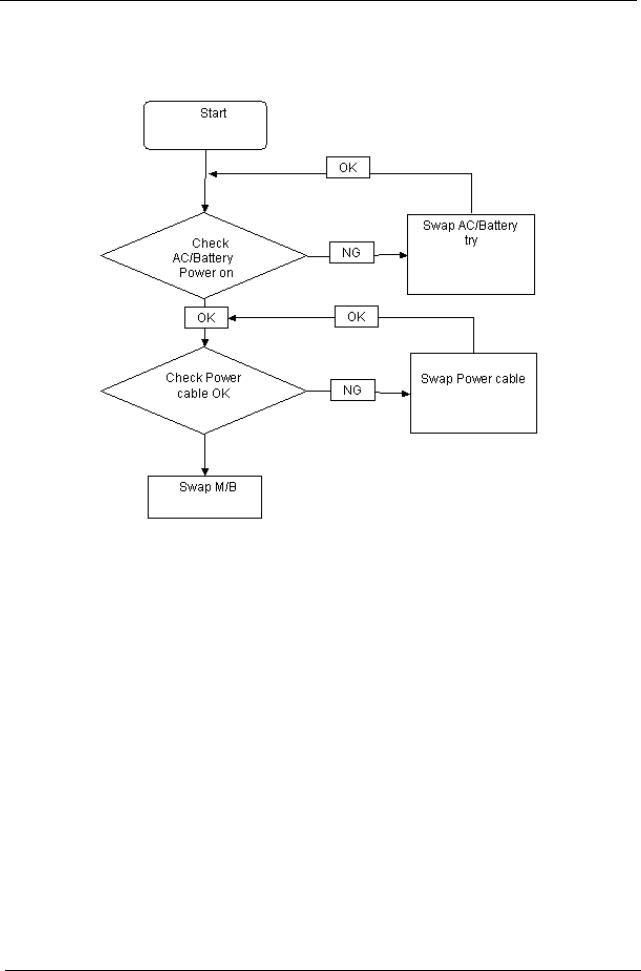
Power On Issue
If the system doesn’t power on, perform the following actions one at a time to correct the problem. Do not replace a non-defective FRU:
Computer Shuts Down Intermittently
If the system powers off at intervals, perform the following actions one at a time to correct the problem.
1.Check the power cable is properly connected to the computer and the electrical outlet.
2.Remove any extension cables between the computer and the outlet.
3.Remove any surge protectors between the computer and the electrical outlet. Plug the computer directly into a known good electrical outlet.
4.Remove all external and non-essential hardware connected to the computer that are not necessary to boot the computer to the failure point.
5.Remove any recently installed software.
6.If the Issue is still not resolved, see “Online Support Information” on page 185.
92 |
Chapter 4 |
Downloaded from www.Manualslib.com manuals search engine
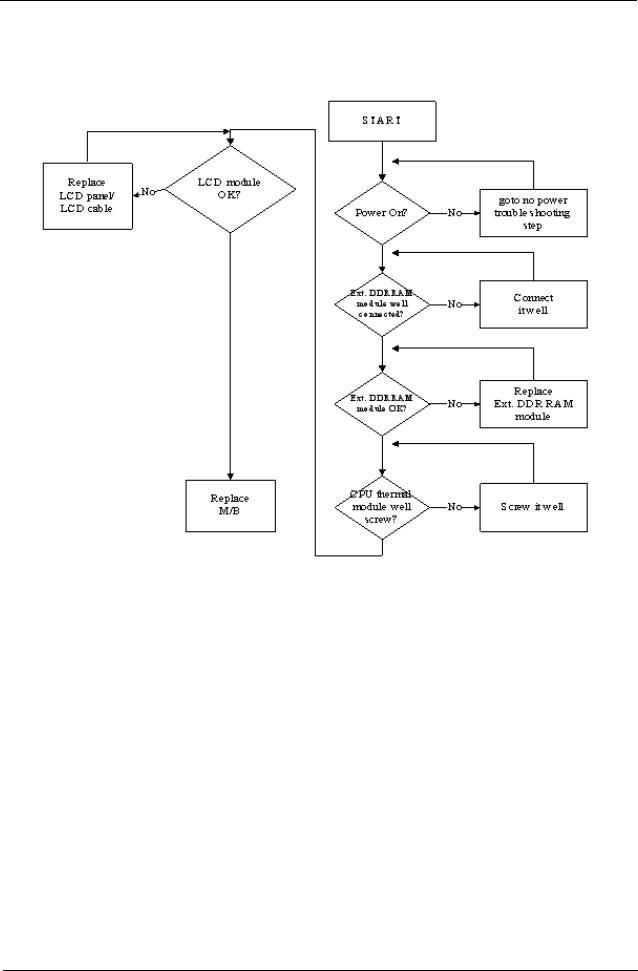
No Display Issue
If the Display doesn’t work, perform the following actions one at a time to correct the problem. Do not replace a non-defective FRUs:
No POST or Video
If the POST or video doesn’t display, perform the following actions one at a time to correct the problem.
1.Make sure that the internal display is selected. On this notebook model, switching between the internal display and the external display is done by pressing Fn+F5. Reference Product pages for specific model procedures.
2.Make sure the computer has power by checking at least one of the following occurs:
•Fans start up
•Status LEDs light up
If there is no power, see “Power On Issue” on page 92.
3.Drain any stored power by removing the power cable and battery and holding down the power button for 10 seconds. Reconnect the power and reboot the computer.
4.Connect an external monitor to the computer and switch between the internal display and the external display is by pressing Fn+F5 (on this model).
If the POST or video appears on the external display, see “LCD Failure” on page 96.
5.Disconnect power and all external devices including port replicators or docking stations. Remove any memory cards and CD/DVD discs. Restart the computer.
If the computer boots correctly, add the devices one by one until the failure point is discovered.
6.Reseat the memory modules.
Chapter 4 |
93 |
Downloaded from www.Manualslib.com manuals search engine

7.Remove the drives (see “Disassembly Process” on page 40).
8.If the Issue is still not resolved, see “Online Support Information” on page 185.
Abnormal Video Display
If video displays abnormally, perform the following actions one at a time to correct the problem.
1.Reboot the computer.
2.If permanent vertical/horizontal lines or dark spots display in the same location, the LCD is faulty and should be replaced. See “Disassembly Process” on page 40.
3.If extensive pixel damage is present (different colored spots in the same locations on the screen), the LCD is faulty and should be replaced. See “Disassembly Process” on page 40.
4.Adjust the brightness to its highest level. See the User Manual for instructions on adjusting settings. NOTE: Ensure that the computer is not running on battery alone as this may reduce display brightness.
If the display is too dim at the highest brightness setting, the LCD is faulty and should be replaced. See “Disassembly Process” on page 40.
5.Check the display resolution is correctly configured:
a.Minimize or close all Windows.
b.If display size is only abnormal in an application, check the view settings and control/mouse wheel zoom feature in the application.
c.If desktop display resolution is not normal, right-click on the desktop and select
Personalize´ Display Settings.
d.Click and drag the Resolution slider to the desired resolution.
e.Click Apply and check the display. Readjust if necessary.
6.Roll back the video driver to the previous version if updated.
7.Remove and reinstall the video driver.
8.Check the Device Manager to determine that:
•The device is properly installed. There are no red Xs or yellow exclamation marks.
•There are no device conflicts.
•No hardware is listed under Other Devices.
9.If the Issue is still not resolved, see “Online Support Information” on page 185.
10. Run the Windows Memory Diagnostic from the opera ting system DVD and follow the onscreen prompts. 11. If the Issue is still not resolved, see “Online Support Information” on page 185.
94 |
Chapter 4 |
Downloaded from www.Manualslib.com manuals search engine

Random Loss of BIOS Settings
If the computer is experiencing intermittent loss of BIOS information, perform the following actions one at a time to correct the problem.
1.If the computer is more than one year old, replace the CMOS battery.
2.Run a complete virus scan using up-to-date software to ensure the computer is virus free.
3.If the computer is experiencing HDD or ODD BIOS information loss, disconnect and reconnect the power and data cables between devices.
If the BIOS settings are still lost, replace the cables.
4.If HDD information is missing from the BIOS, the drive may be defective and should be replaced.
5.Replace the Motherboard.
6.If the Issue is still not resolved, see “Online Support Information” on page 185.
Chapter 4 |
95 |
Downloaded from www.Manualslib.com manuals search engine

LCD Failure
If the LCD fails, perform the following actions one at a time to correct the problem. Do not replace a nondefective FRUs:
96 |
Chapter 4 |
Downloaded from www.Manualslib.com manuals search engine
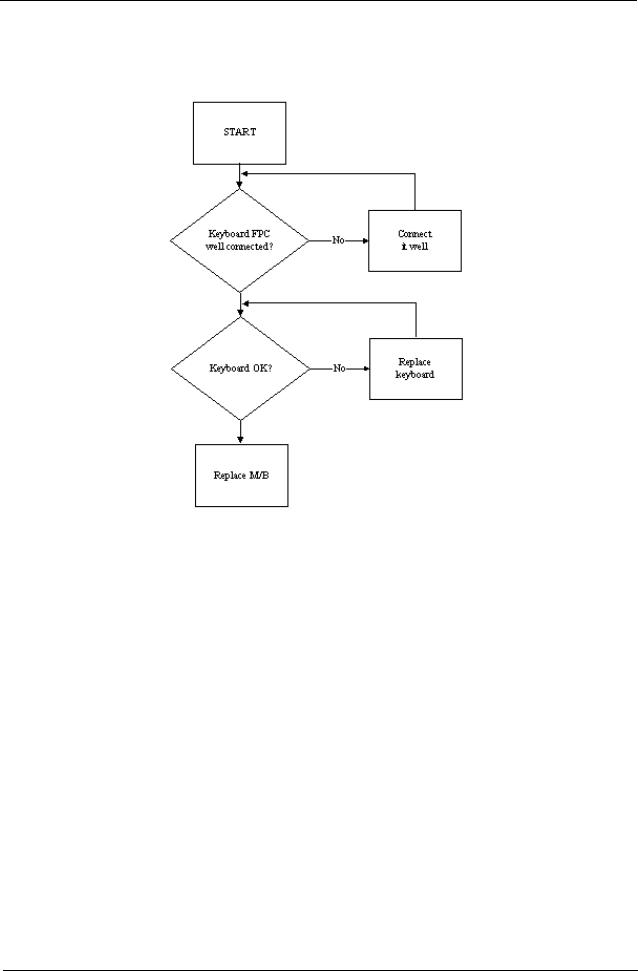
Built-In Keyboard Failure
If the built-in Keyboard fails, perform the following actions one at a time to correct the problem. Do not replace a non-defective FRUs:
Chapter 4 |
97 |
Downloaded from www.Manualslib.com manuals search engine
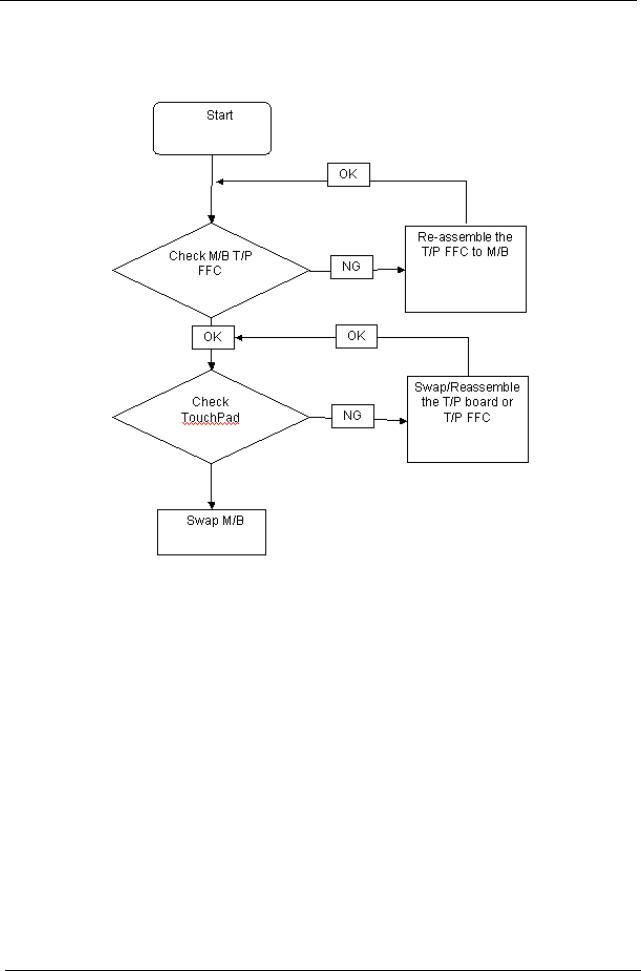
TouchPad Failure
If the TouchPad doesn’t work, perform the following actions one at a time to correct the problem. Do not replace a non-defective FRUs:
98 |
Chapter 4 |
Downloaded from www.Manualslib.com manuals search engine
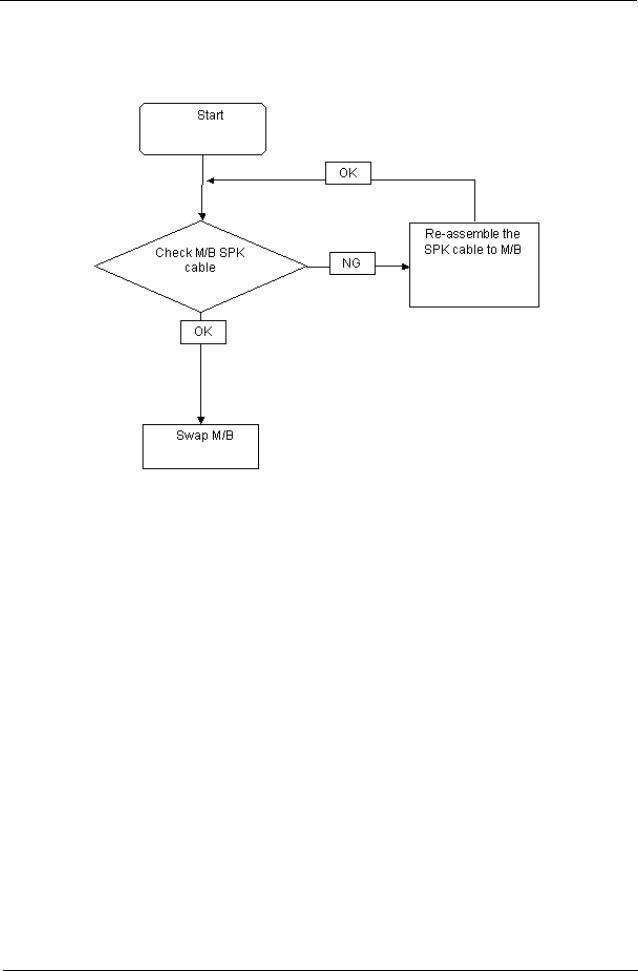
Internal Speaker Failure
If the internal Speakers fail, perform the following actions one at a time to correct the problem. Do not replace a non-defective FRUs:
Sound Problems
If sound problems are experienced, perform the following actions one at a time to correct the problem.
1.Reboot the computer.
2.Navigate to Start´ Control Panel´ System and Maintenance´ System´ Device Manager. Check the Device Manager to determine that:
•The device is properly installed.
•There are no red Xs or yellow exclamation marks.
•There are no device conflicts.
•No hardware is listed under Other Devices.
3.Roll back the audio driver to the previous version, if updated recently.
4.Remove and reinstall the audio driver.
5.Ensure that all volume controls are set mid range:
a.Click the volume icon on the taskbar and drag the slider to 50. Ensure that the volume is not muted.
b.Click Mixer to verify that other audio applications are set to 50 and not muted.
6.Navigate to Start´ Control Panel´ Hardware and Sound´ Sound. Ensure that Speakers are selected as the default audio device (green check mark).
NOTE: If Speakers does not show, right-click on the Playback tab and selectShow Disabled Devices (clear by default).
7.Select Speakers and click Configure to start Speaker Setup. Follow the onscreen prompts to configure the speakers.
8.Remove and recently installed hardware or software.
Chapter 4 |
99 |
Downloaded from www.Manualslib.com manuals search engine

9.Restore system and file settings from a known good date using System Restore.
If the issue is not fixed, repeat the preceding steps and select an earlier time and date.
10.Reinstall the Operating System.
11.If the Issue is still not resolved, see “Online Support Information” on page 185.
100 |
Chapter 4 |
Downloaded from www.Manualslib.com manuals search engine
